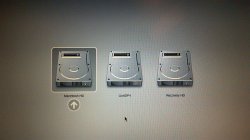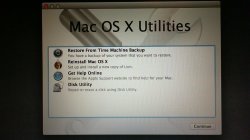This is how Lion works, and how it WILL install - if I am wrong, I'll give you a cheesecake!:
1/ You run the installer app
2/ Installer app asks where you wish to install
3/ Regardless of your chosen drive/volume, Lion creates a "restore" partition (think of it as equivalent to the install DVD)
3b/ Installer app reboots the Mac, and temporarily boots from the "restore" partition which it created in *phase 1* of the installation
4/ If you didn't choose a volume different to the one from which you were booted when you ran the installer, Installer app *phase 2* will ask if you wish to upgrade OR clean install (note: phase 2 runs from "restore" partition that *phase 1* created, before it rebooted, so that the installer can complete the process. THIS PARTITION IS HIDDEN - YOU WON'T SEE IT IN DU - doesn't mean it isn't there!
It seems you need ONLY to copy the Installer app, and NOT the right-click >> extract DMG method (ridiculous notion that this would be expected of HOME USERS!) to another Mac to install, after having copied it from a Mac which had/has Mac App Store access, in order to install on other Macs.
Am I wrong? Unlikely - seems MOST people think differently, which is why most people are getting totally muddled - over-analysis coupled with very little/no knowledge of how Mac OS X and computer systems in general partition disks/restore partitions, is likely causing all this FUD.
[EDIT]
You can boot from the recovery partition, open Disk Utility and erase other partitions, including the one to which you installed Lion, so there IS a hidden recovery partition of sorts - I've just watched someone do this!!
A)
If you erase the partition onto which you installed Lion, using the "restore" partition version of DU, and then boot into SL, open SL DU and highlight the Lion partition you just erased, VISUALLY it shows it is all empty space (no blue bar) but in the size description, 5-6Gb is missing...
B) If you use SL DU and highlight the Lion partition, and click (-) to remove it, and once done, drag the SL slider RIGHT DOWN to fill the free space, and then reboot holding OPT, the "restore" partition has gone, and no option is there to boot from it!
Magic!
1/ You run the installer app
2/ Installer app asks where you wish to install
3/ Regardless of your chosen drive/volume, Lion creates a "restore" partition (think of it as equivalent to the install DVD)
3b/ Installer app reboots the Mac, and temporarily boots from the "restore" partition which it created in *phase 1* of the installation
4/ If you didn't choose a volume different to the one from which you were booted when you ran the installer, Installer app *phase 2* will ask if you wish to upgrade OR clean install (note: phase 2 runs from "restore" partition that *phase 1* created, before it rebooted, so that the installer can complete the process. THIS PARTITION IS HIDDEN - YOU WON'T SEE IT IN DU - doesn't mean it isn't there!
It seems you need ONLY to copy the Installer app, and NOT the right-click >> extract DMG method (ridiculous notion that this would be expected of HOME USERS!) to another Mac to install, after having copied it from a Mac which had/has Mac App Store access, in order to install on other Macs.
Am I wrong? Unlikely - seems MOST people think differently, which is why most people are getting totally muddled - over-analysis coupled with very little/no knowledge of how Mac OS X and computer systems in general partition disks/restore partitions, is likely causing all this FUD.
[EDIT]
You can boot from the recovery partition, open Disk Utility and erase other partitions, including the one to which you installed Lion, so there IS a hidden recovery partition of sorts - I've just watched someone do this!!
A)
If you erase the partition onto which you installed Lion, using the "restore" partition version of DU, and then boot into SL, open SL DU and highlight the Lion partition you just erased, VISUALLY it shows it is all empty space (no blue bar) but in the size description, 5-6Gb is missing...
B) If you use SL DU and highlight the Lion partition, and click (-) to remove it, and once done, drag the SL slider RIGHT DOWN to fill the free space, and then reboot holding OPT, the "restore" partition has gone, and no option is there to boot from it!
Magic!
Attachments
Last edited:



